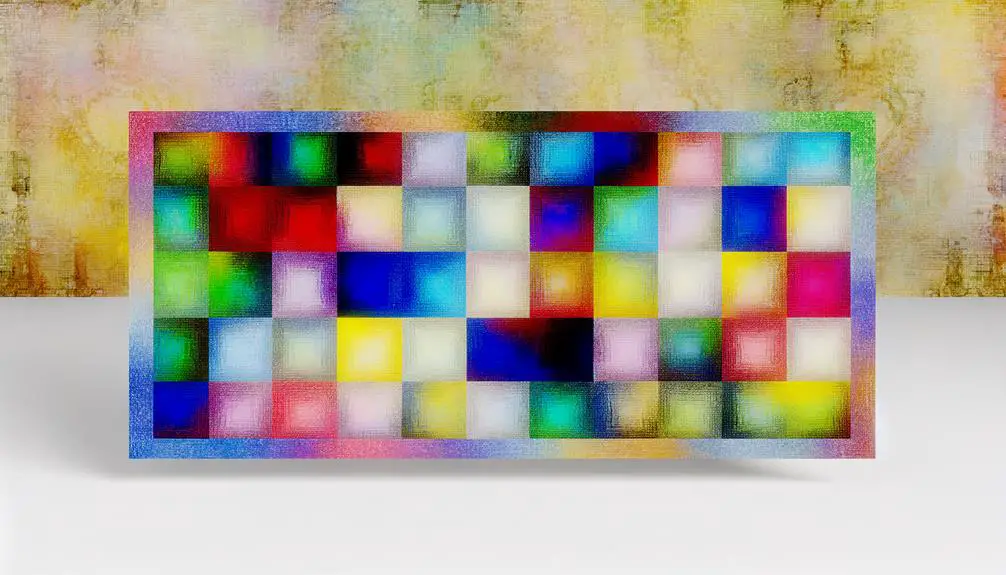Unlocking Stability with the Square Symbol: Meaning for Your Life
The square is a potent symbol embodying stability, order, and rationality across numerous cultures and time periods. In ancient civilizations like Mesopotamia, China, and Egypt, squares were central to architecture, city planning, and spiritual practices, signifying harmony and the material world.
Philosophically, it represents structured thinking and justice, while spiritually it bridges the earthly and divine. Architecturally, the square's symmetry and balance influence design principles, from Egyptian temples to modern structures.
Psychologically, the square evokes emotional stability and security, fostering clarity and focus. To explore how deeply the square intertwines with human life and accomplishments, keep exploring.

Key Takeaways
- The square symbolizes stability, order, and the material world across various ancient civilizations.
- Philosophically, the square represents rationality, balance, and human understanding of a structured universe.
- Spiritually, the square signifies interconnectedness, stability, and the bridge between the earthly and divine.
- Architecturally, squares convey stability, order, and cultural values, influencing both ancient and modern designs.
- Psychologically, squares promote emotional stability, security, and clarity, fostering trust and systematic thinking.
Historical Significance

Throughout history, the square symbol has held profound significance across various cultures, representing concepts such as stability, order, and the material world.
In ancient Mesopotamia, the square was a fundamental element in city planning, reflecting societal priorities for structure and predictability.
Similarly, in ancient China, the square's symmetry was integral to feng shui principles, symbolizing the earth and grounding human activities in harmony with nature.
Classical Greek philosophy also revered the square, associating it with rationality and balance, as evident in their architectural marvels.
These historical contexts underscore the square's role not merely as a geometric form but as an emblem of human aspiration towards an orderly, stable existence, deeply ingrained in the collective consciousness across civilizations.
Cultural Representations
From sacred art to modern architecture, the square symbol manifests diversely across cultures, embodying profound meanings that transcend mere geometry.
In ancient Egypt, squares represented the Earth and its grounded, stable nature, often seen in the meticulous design of pyramids and temples.
In Chinese culture, the square symbolizes Earth in the cosmological balance of the universe, juxtaposed with the circular heavens.
Native American tribes, particularly the Hopi, use the square in their spiritual sand paintings to denote order and harmony.
Contemporary architecture also harnesses the square's symbolism, emphasizing functionality and minimalism, as seen in the Bauhaus movement.
These cultural representations reveal the square's enduring influence, encapsulating concepts of stability, balance, and universal harmony across diverse societies.
Philosophical Interpretations

In the domain of philosophical thought, the square symbol encapsulates notions of rationality, order, and the human quest for understanding the cosmos. Philosophers have long interpreted the square as an emblem of stability and balance, reflecting the structured nature of the universe and human cognition. This shape, with its equal sides and right angles, resonates with the principles of logic, symmetry, and justice, serving as a metaphor for the ideal state of human affairs.
| Aspect | Interpretation |
|---|---|
| Rationality | Logical thinking, structured argumentation |
| Order | Systematic arrangement, harmony |
| Human Understanding | Cognitive clarity, pursuit of knowledge |
| Balance | Equilibrium, fairness in human interaction |
In this context, the square is more than a geometric figure; it is a philosophical archetype reflecting humanity's intrinsic need for coherence and comprehension.
Spiritual Symbolism
In spiritual contexts, the square often symbolizes balance and stability, representing the four cardinal directions and the foundation of physical and metaphysical domains.
Sacred geometry further enhances this interpretation, where the square's equal sides and angles are seen as a reflection of cosmic order and harmony.
This geometric perfection is thought to serve as a bridge between the earthly and the divine, grounding spiritual practice in a structured, harmonious framework.
Balance and Stability
Rooted deeply in various spiritual traditions, the square symbol is often interpreted as an emblem of balance and stability, representing the foundational elements of order and harmony in life.
In many cultures, the square's four equal sides and angles symbolize the four cardinal directions or elements—earth, air, fire, and water—integrating the material and spiritual domains. This geometric shape evokes a sense of groundedness and uniformity, mirroring the human quest for equilibrium in a chaotic world.
For instance, in Native American spirituality, the Medicine Wheel incorporates the square to denote the interconnectedness of life cycles. Across different faiths, the square serves as a reminder that true stability arises from a harmonious alignment of mind, body, and spirit.
Sacred Geometry Insights
Sacred geometry views the square as a profound symbol that encapsulates the essence of spiritual order and cosmic balance, transcending mere physical dimensions to convey deeper metaphysical truths. In various cultures and esoteric traditions, the square signifies:
- Foundation: Represents the earth element, grounding energies, and stability.
- Perfection: Emblematic of completeness and the harmonious integration of all parts.
- Protection: Symbolizes a sacred space, encapsulating safety and divine order.
- Transformation: Marks the journey from the earthly plane to spiritual enlightenment.
The square's four equal sides mirror the four cardinal directions, the four seasons, and the four elements, making it a universal archetype. This geometric form serves as a bridge between the tangible world and the mystical domains, inviting seekers to explore its inherent wisdom.
Architectural Influence

The architectural significance of the square has been profound throughout history, serving as a foundational element in both ancient and contemporary structures.
From the enduring symmetry of Greek temples to the modernist geometrical designs of the 20th century, the square has symbolized stability, order, and balance.
This geometric form continues to influence modern design applications, reflecting cultural values of simplicity and functionalism.
Historical Architectural Significance
Throughout history, the square symbol has profoundly influenced architectural design, serving as a foundational element in the construction of temples, civic buildings, and urban planning. Its significance can be traced back to ancient civilizations where it embodied stability and order.
For instance:
- Egyptian Temples: The square base of the pyramids symbolized the earth's four corners, representing earthly and divine harmony.
- Greek Agoras: Central squares in Greek cities facilitated democratic gatherings, reflecting societal balance.
- Roman Forums: These rectangular spaces were the heart of civic life, underscoring the structured nature of Roman society.
- Medieval Cathedrals: The square floor plans provided a sense of celestial order, aligning earthly structures with heavenly principles.
Such historical usage highlights the square's role in shaping cultural and architectural paradigms.
Modern Design Applications
Building upon its historical foundations, the square symbol continues to exert significant influence in modern architectural design, embedding notions of stability and harmony into contemporary built environments.
Architects leverage the square's geometric purity to create spaces that evoke a sense of order and balance. This shape is often employed in urban planning, residential layouts, and public structures to symbolize reliability and integrity.
The square's cultural resonance with equality and fairness also informs its use in communal spaces, promoting inclusivity and unity. Through interpretative insight, the square's application extends beyond aesthetic appeal, integrating into the very philosophy of space-making, where form follows function, and each line delineates a purposeful, thoughtful design.
Mathematical Importance
Square symbols hold profound significance in mathematics, representing concepts such as stability, equality, and precision through geometric properties and algebraic equations. The square's equal sides and right angles embody a sense of balance and order, resonating with axioms and theorems that underpin mathematical theory.
Mathematically, squares evoke emotional responses due to their inherent properties:
- Precision: Each angle is exactly 90 degrees, symbolizing perfect accuracy.
- Symmetry: Their sides are congruent, offering a visual representation of equality.
- Area Calculation: The formula \(A = s^2\) simplifies complex spatial understandings.
- Pythagorean Theorem: Squares are fundamental in proving relationships in right triangles.
Artistic Expressions

While the square's mathematical significance is evident, its influence extends deeply into the field of artistic expression, where it serves as a potent symbol of structure, harmony, and conceptual depth.
Historically, the square has been utilized in various cultures, from the symmetrical rigor of Islamic tile work to the balanced compositions of Renaissance paintings. Artists like Piet Mondrian embraced the square to explore abstract purity and geometric harmony.
In contemporary art, the square continues to evoke stability and order, acting as a canvas for complex ideas and emotions. Its four equal sides and right angles offer a sense of completeness and balance, inviting viewers to contemplate the underlying order within chaos.
The square embodies a universal language of artistic coherence.
Psychological Impact
The square, often perceived as a symbol of emotional stability, can profoundly influence an individual's psychological landscape by promoting a sense of balance and security.
Cognitive interpretation patterns associated with squares often evoke feelings of order and predictability, which can be essential in reducing anxiety and enhancing mental clarity.
Additionally, the square's impact on behavior may manifest in a preference for structured environments and systematic approaches to problem-solving, reflecting its broader cultural significance as a paradigm of rationality and reliability.
Emotional Stability Symbolism
In various cultural contexts, the square symbol is often interpreted as a representation of emotional stability, suggesting a psychological foundation that offers individuals a sense of security and balance. This geometric shape evokes a feeling of order and predictability, which can be essential for emotional well-being. The square embodies:
- Consistency: Its equal sides signify reliability and uniformity.
- Grounding: As a stable base, it anchors emotions, providing a sense of rootedness.
- Protection: Enclosed lines create a boundary, offering a safeguarded space.
- Harmony: Symmetry within the square symbolizes equilibrium and internal peace.
These elements collectively contribute to a stable emotional landscape, reinforcing the square's role in fostering a secure and balanced psychological state.
Cognitive Interpretation Patterns
Cognitive interpretation patterns of the square symbol reveal profound psychological impacts. This geometric figure often signifies mental order, structure, and a methodical approach to problem-solving across various cultural paradigms.
In Western societies, the square is synonymous with rationality and stability, echoing the Cartesian grid's influence on scientific thought. Eastern philosophies view the square as a representation of earth and material reality, emphasizing balance and grounded practicality.
Psychologically, the square's equal sides and right angles foster a sense of predictability and control, reducing cognitive dissonance and enhancing mental clarity. This symbol's universal presence in architecture and design underscores its role in cultivating an environment conducive to logical reasoning and systematic thinking, essential for cognitive coherence and psychological well-being.
Behavioral Influence Factors
Many studies have demonstrated that the square symbol greatly influences human behavior by fostering a sense of stability and predictability, which are essential for psychological resilience and effective decision-making. This geometric form is deeply ingrained in cultural contexts worldwide, symbolizing order and reliability.
The psychological impact of the square can be analyzed through various lenses:
- Comfort: Squares create environments that feel secure and dependable, reducing anxiety.
- Focus: The structure of squares helps individuals concentrate, promoting productivity.
- Trust: Repeated exposure to square patterns can enhance feelings of trust and authenticity.
- Organization: Squares encourage systematic thinking, aiding in problem-solving and planning.
Understanding these influences allows for a richer interpretation of how symbols shape human experience.
Nature's Patterns

Throughout history, the square has emerged as a significant geometric form in nature's patterns, symbolizing stability, order, and the foundational structures of the natural world.
In geological formations, crystalline structures often adopt a square or cubic configuration, exemplifying nature's propensity for symmetry and balance.
Similarly, in botany, the square stem of the mint family reflects a natural inclination towards structural efficiency. These occurrences suggest an intrinsic alignment with the principles of order and predictability.
Culturally, the square's presence in nature has influenced architectural and societal constructs, reinforcing a collective appreciation for harmony and proportion. The square serves as a bridge, connecting human ingenuity with the inherent design principles observed in the natural world.
Everyday Applications
Building on its symbolic significance in nature, the square also permeates everyday life, manifesting in various applications that underscore its association with stability, functionality, and aesthetic order.
In urban planning, the grid layout of streets exemplifies the square's role in creating organized, navigable spaces. Architectural designs utilize square shapes to convey strength and symmetry.
In art, squares are fundamental in abstract compositions, reflecting balance and precision. The square's ubiquity in digital interfaces, from icons to screens, accentuates its functional clarity.
Consider the emotional resonance of these applications:
- Urban Planning: A sense of navigational ease.
- Architecture: Architectural strength and reliability.
- Art: Visual balance and harmony.
- Digital Interfaces: User-friendly functionality.
These instances reveal the square's profound impact on daily life.
Personal Development

In personal development, the square symbolizes a structured approach to growth, emphasizing the importance of balance, discipline, and foundational strength in one's journey toward self-improvement.
This geometric form, with its equal sides and right angles, represents stability and consistency. Cultural interpretations often link the square to the four elements—earth, water, air, and fire—illustrating the necessity of harmonizing various life aspects.
Additionally, the square can be seen as a metaphor for setting clear boundaries and goals, which are essential for personal growth. By adopting the square's principles, individuals can methodically address their weaknesses, build on their strengths, and cultivate a well-rounded character, thereby achieving a more balanced and fulfilling life.
Conclusion
The square symbol, with its multifaceted significance, transcends mere geometry to embody a cosmic blueprint for human understanding. Across history, culture, philosophy, spirituality, architecture, psychology, nature, and daily life, it emerges as a cornerstone of existential meaning.
Its omnipresence is nothing short of a universal archetype, providing structural clarity and profound insight. The square's influence on personal development and collective consciousness is a reflection of its unparalleled impact on the human psyche and civilization.






